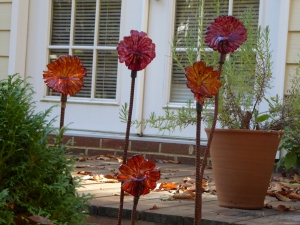By Patricia Paquette
December 2016
My neighbor laughed when he walked to his mailbox the other day and said, “You remind me of a garden gnome – every time I see you, you’ve popped up somewhere else in the yard.” He was thinking of the red-hatted garden gnomes that have become popular in a good taste-bad taste sort of way these days. The little guys have even played starring roles in elaborate pranks, in which they are “kidnapped” and taken on vacation by the pranksters, who photograph them at famous sites (on the edge of the Grand Canyon, at Disney World, the Eiffel Tower). From what I’ve heard, they’re usually returned to their gardens, complete with a packet of souvenir photos, at the end of their outings.
I’d like to think the traveling gnomes enjoyed the vacation from their duties as garden sentries and good luck charms.
But: A Family of Gnomes?
“Just what makes a statue or ornament acceptable really depends on individual taste,” writes British garden designer David Stevens in Town Gardens. “Brightly colored gnomes are considered so appalling by some as to bring on an instant headache. But don’t become a gardening snob,” he says. “If you want a gnome, then by all means have one, or a family of them. Gardening is after all fun, and as soon as you remove that essential sense of humour the whole exercise becomes dull.”
I say, ask yourself, “what would a redhead do”?
Or Flocks of Flamingos?
In 1957, flamingos began their migration from the tropics and subtropics to gardens and yards across the country. That’s when the familiar fake plastic birds were created by artist Don Featherstone in Leominster, Mass. In later interviews, he ascribed their popularity to the postwar subdivisions of similar-looking suburban houses, says Smithsonian online.

“You had to mark your house somehow,” Featherstone says. “A woman could pick up a flamingo at the store and come home with a piece of tropical elegance under her arm to change her humdrum house.” She would’ve paid $2.76 a pair for the first models.
In 1987, CNN online says, “the governor of Massachusetts proclaimed the plastic birds ‘an essential contribution to American folk art,’ wrote historian Jennifer Price in her book, Flight Maps.” By 1998, the Los Angeles Museum of Contemporary Art was selling the flamingos for $19 pair. The plastic flamingo’s birthright includes plenty of social commentary explaining their waxing and waning popularity over the decades. At this point, however, they don’t seem to be an endangered species. And they may even be something Americans can agree on.
And Fairies, Too?
Last time I looked, more than 1,000 images of fairy gardens were posted on Pinterest. Fairy gardening has become “more than a trend,” says GardenCenter, a trade magazine for garden retailers. The retailers are meeting consumer demand with special sections displaying everything from tiny houses, arbors, stepping stones and plants (succulents, miniature conifers, mosses) to, of course, the fairies themselves. Centers also present workshops where gardeners (and their fairy-clad youngsters) learn the basics of design and care for their mini-landscaping. Customers have taken to this trend, the magazine says, “because it offers opportunities to let imaginations run wild, and the potential to do so is unlimited.”
Ghosts & Ghouls
Ghouls rising up from damp earth. Gargantuan spiders pouncing on porches. Witches in the shrubbery. All are familiar in Halloween displays every fall. U.S. consumers were expected to spend $8.4 billion for the holiday in 2016 – an all-time high in the 11-year history of the annual survey conducted by Prosper Insights & Analytics for the National Retail Federation. The report also notes that more than 171 million Americans were planning to partake in Halloween festivities. And then costumes and props go back into storage to make room for the holidays of December.
Whimsy

“Whimsy” is one of 12 essential design principles outlined by American garden and lifestyle expert P. Allen Smith and, he says, it’s “an element I try to incorporate in all of my garden design.” In his first guidebook, Garden Home, Smith tells about his design proposal to a friend with “a houseful of exceptionally ‘quotable’ children”: He suggested “immortalizing some of their humorous statements by engraving them into stepping-stones for her garden.” The bottom line? “Humorous responses to nature and the garden help us to maintain a healthy perspective and attitude about life.”
Too Many Tchotchkes?
DIY gardener Susan Martin outlines the successful transformation of her bare suburban Illinois yard into a lush and well-loved garden in This Old House. One of five “Time-Tested Tips” she learned and shared with TOH writers and readers is to edit non-plant objects in the garden. “Sculptures, antique farm implements, and other art elements add pizzazz and a personal touch to a garden,” TOH says, “but if you want them to work as accents, not background noise, you have to choose carefully. Susan displayed everything she received as gifts or found at flea markets. Then a visitor to her garden made a remark about ‘tchotchkes,’ and she realized her garden had become too cluttered. She edited down her display and now features a single large piece in each bed.”
Smart Replies
What do you say to someone who asks for your opinion about their garden? Steve Bender, Southern Living’s popular and respected “grumpy gardener,” has a distinctively Southern answer in the 2016 Golden Anniversary edition of the magazine. “Answer smartly” he says, when a person asks what you think of their (to you, anyway) ugly yard. “Try, ‘That’s really something!’ Or ‘I’ve never seen that before!’ or, ‘Who would have thought of that?’ he advises. “But never say, ‘Bless your heart’,” because, “If you do, they’ll know you think it’s ugly.”

Love this, but I don’t think I’ll run out and buy plastic flamingos! Glass flowers for whimsy? Now that’s what I’d like growing in my garden.
LikeLike